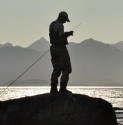After
awakening on June 4, 2011, with the eruption at the Puyehue-Caulle Volcanic
Complex, different organizations immediately started monitoring the area in
order to identify the implications of this phenomenon on the environment.
Different protocols were applied, and still do, in different environments of the area (rivers, lakes, streams, forest, and steppe) in order to figure out how the presence of the ash was going to affect the environment.
Within these samples, in fishing environments, on Sunday September 11 there was a special tracking in Limay´s River in conjunction with staff from the Nahuel Huapi´s National Park, to monitor the health status of salmonids, one of the most important fishing resources of the region.
To do so, two boats and five fishermen were enabled to float from the highway bridge located 200 meters from the headwaters of Limay River on Nahuel Huapi´s Lake, to the area known as "El Pinar", approximately 25 kilometers down.
The group of fishermen who conducted the mentioned survey was teamed by four professional fly fishing guides: Francisco Rodriguez, Luciano Bacci, Sebastian Tacchino and Darío Arrieta, Nahuel Huapi´s National Park and Northern Patagonia Professional Fishing Guide Secretary, and by Marcelo Boungarzoni, a fisherman guest.
Even though the chosen day was far from optimal, since the weather was rainy and cold, the typical visibility of the river could be admired as the watercourse had removed all the ash during the first days of the geological phenomenon.
As a first observation, an increase of filamentous greenish algae was detected; most evident in the first sections, where they had not been registered in such quantity in samples taken weeks ago. The algae could be observed up to 2 meters from the bank and in low depth places (up to 40 cm.). As a consequence, monitoring on the growth of this species was determined to be increased.
Although accumulation of ash and sand could be distinguished in the banks, two areas were differentiated on the river:
1) In strong current places there was no accumulation of ash or sand. The formation in the bottom could be clearly seen, as in previous surveys.
2) In backwaters and swift current areas, the bottom was covered with ¾ inches of sand.
However, considering that the river has not yet reached its peak flood, it is expected that after that, the current will further clean the ashes.
Within the activities undertaken, a scan job of nymphs was conducted. As a result, an interesting amount of them were identified in sectors occupied by sand, but not in places covered by algae. Adult Mayflies could be isolated but there was no presence of surface feeding fish: however, the usual jumps and fights characteristic of territorial struggles during spawning season were observed.
In relation with fish sampling, it started in the area of the highway bridge where after 15 minutes two healthy and vigorous Rainbow trout specimens were caught, a female and a male fish, both mature adults weighing over 2 kilos and in ideal conditions as their gills were okay. After noticing the presence of several specimens, the place was abandoned to avoid disturbing them unnecessarily.
While
floating downstream it could be observed that the river was in a good health
and in an advanced state of recovery; water was clear despite the persistent rain from the night before. As
regards the water close to the banks, it maintained a layer of sand and
filamentous algae.
In the specific sectors where fishing testing was accomplished, the specimens caught were mostly healthy and strong Rainbow touts, bearing the hallmarks of the struggle for spawning. Also, smaller fish were captured, what clearly showed that the environment was safe and sound. Brown trout were in perfect condition, strong and with healthy gills.
To conclude, according to the observations made in this survey and in previous ones, the river conditions were almost normal, with evidence of healthy specimens. In order to support this affirmation, it must be known that in one of the fishing days, after 10 hours, 5 fishermen caught 30 trout of different sizes (between 500 grams and 4 kilos), predominantly Browns and Rainbows, which in the middle of spawning season were all in perfect conditions, very sharp and wild.
Therefore, there is no reason to foresee
a bad fishing season during 2012-2013, as the main characters,
the trout and the river, are in perfect shape.
Fernando Méndez Guerrero
Resposible for sport fishing.
NAHUEL HUAPI NATIONAL PARK
San Martín 24- Bariloche- Río Negro (8400)



